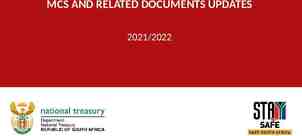Presentation to California Debt and Investment Advisory
12 Slides472.50 KB
Presentation to California Debt and Investment Advisory Commission Short-term and Interim Financing Strategies January 12, 2011 San Francisco Los Angeles San Diego New York Chicago Phoenix Richmond Annapolis Albany
Presentation Overview I. Overview of Short-Term Products II. Market Update III. Strategies for Issuers of Short-Term Products in 2011 2
Short-Term Products Notes with a Fixed Term Tax & Revenue Anticipation Notes (TRANS) Bond Anticipation Notes (BANS) Grant Anticipation Notes (GANS) Tax Anticipation Notes (TANS) Revenue Anticipation Notes (RANS) Remarketed Securities Variable Rate Demand Notes (VDRNS) Commercial Paper (CP) Hybrid/Alternative Structures Indexed Bonds Multi-Modal Structure 3
Notes with a Fixed Term Tax & Revenue Anticipation Notes: Notes issued in anticipation of receiving future tax receipts and revenues. Bond Anticipation Notes: Notes issued for capital projects. Redeemed with proceeds from the issuance of long-term bonds. Grant Anticipation Notes: Notes issued on the expectation of receiving grant moneys, usually from the federal government. The notes are payable from the grant funds, when received. Tax Anticipation Notes: Notes issued in anticipation of receiving future tax receipts at a later date. Revenue Anticipation Notes: Notes issued in anticipation of receiving revenues at a future date. 4
Remarketed Securities Variable Rate Demand Notes: Floating rate obligations that have a nominal long-term maturity but have a coupon rate that is reset periodically. Top 10 Letter of Credit Providers 2009 Top 10 Letter of Credit Providers 2010 Par Amount (Millions) Number of Issues Par Amount (Millions) Number of Issues JP Morgan Chase 3,581.6 50 JP Morgan Chase 1,981.3 28 Wells Fargo Bank 3,021.3 62 Bank of America 1,550.1 24 Bank of America 2,900.8 59 Wells Fargo Bank 561.2 17 U.S. Bank 2,848.5 62 TD Bank 431.6 4 SunTrust Bank 1,064.5 16 Citibank 365.0 5 BB & T 1,007.9 35 PNC Bank 287.1 9 TD Bank 784.3 20 Union Bank 278.1 5 RBS Citizens 443.6 7 Barclays Bank 210.0 2 LOC Bank LOC Bank 365.5 4 U.S. Bank 207.1 Citibank Commercial Paper: Short-term, unsecured promissory notes, usually back by a line of Northern 7 RBS Citizens 193.1 credit Trust with a bank, that360.0 mature within 270 days. (1) 5 2 Source: Thomson Reuters. As of 11/30/2010. 5
Emergence of Alternative Structures Dearth of liquidity spurs development of new products and new approaches SIFMA-Indexed Floating Rate Notes Priced at a fixed spread to weekly SIFMA index No credit enhancement or liquidity required Structuring variations possible: Long-dated amortization and short mandatory put Money market-eligible with mandatory put within 366 days Call flexibility Issuer exposed to future short-term yields, market access and interest rate risk at take-out Multi-Modal Structure Allows for current legal documents to remain in place while alternating between different short term modes. 6
Issuers Continue to Benefit from Short-Term Structures Spread between fixed/floating rates reaches 20-year high 8.0% SIFMA Index Revenue Bond Index Series3 Series4 Spread 283 bps 6.0% (%) Average 5.61% 4.0% Average 2.65% 2.0% 0.0% Dec-90 (1) Dec-94 Dec-98 Dec-02 Dec-06 Dec-10 Source: Bloomberg. As of 1/3/2011. 7
New Issue Volume National Municipal Variable Rate Issuance (2001-2010 YTD) 50 California 2010 variable rate issuance down 30% from 2009 45 separate issues totaling 2.6 billion in 2010 versus 57 issues totaling 3.7 in 2009 2010 YTD 2009 2008 2007 2006 2001 2010 YTD 2009 2008 0 2007 0 2006 10 2005 20 2004 20 2003 40 2002 30 2001 60 2005 40 2004 80 60 2003 100 70 2002 120 ( Billions) Auction Rate Linked Rate Variable Rate (Short Put) 140 ( Billions) National Municipal Fixed Rate Note Issuance (2001-2010 YTD) California 2010 fixed rate note issuance up 11% from 2009 107 separate issues totaling nearly 19 billion in 2010 versus 96 issues totaling 17.3 in 2009 ce for Charts: Thomson Reuters. As of 11/30/2010 ce for CA Issuance Data: Thomson Reuters and Ipreo. As of 12/27/2010. 8
Variable Rate Market Update Market characterized by liquidity scarcity, reduced issuance, historically low rates Interest rate environment Tax-Exempt Money Market Funds Supply and demand SEC rule 2a-7 amendments Basel III 200 -10 100 -15 Jan-11 Nov-10 Sep-10 Jul-10 Mar-10 0 Jan-10 -20 May-10 Regulatory Changes -5 Nov-09 High costs & onerous provisions moderating? 300 0 Sep-09 Fewer one-stop shops; many providers want ancillary business 5 Jul-09 Capacity and saturation pressures persist 400 May-09 10 Jan-09 Scarcity of liquidity persists; number of providers dwindles and concentration is high 500 15 Mar-09 20 Nov-08 Credit enhancement landscape 600 Tax-Exempt Money Market Assets Fund Assets ( Billions) Tax-exempt money fund assets decline as risk aversion continues to ease 25 Jul-08 Assets and Fund Flows as of 1/3/2011 Significantly diminished overall issuance volume; indexed bonds increase market share Fund Flows ( Billions) Sep-08 Steep yield curve due to accommodative Fed May-08 Jan-08 Extremely low short-term rates persist; SIFMA resets higher at 0.34% Mar-08 Source: Bond Buyer & Investment Company Institute. As of 1/3/2011. 9
SIFMA Index: 20-Year History Municipal variable rates remain near all-time lows Securities Industry & Financial Markets Association (SIFMA) Index1 1.2% 8.0% Max 7.96% Min 0.15% Current 0.34% 7.0% 0.8% Average 0.34% 0.4% 6.0% 0.0% Jan-09 5.0% Jul-09 Jan-10 Jul-10 Jan-11 4.0% Average 2.65% 3.0% 2.0% 1.0% 0.0% Jan-91 (1) Jan-95 Jan-99 Jan-03 Jan-07 Jan-11 Source: SIFMA. All bonds in Index must be tax-exempt, non-AMT, have 10mm or more outstanding and the highest short-term rating by Moody’s or S&P, and pay interest monthly with interest rate resets occurring on Wednesdays. As of 1/3/2011. 10
Short-Term Interest Rate Update Fed’s easy monetary policy keeps short-term rates near historic lows 2-Year Treasury & Fed Funds Target Rate1 7.0 6.0 5.0 4.0 (%) 3.0 Average 2.72% Average 2.39% 2.0 2-Year U.S. Treasury Fed Funds Target Rate 2-yr avg ff avg 1.0 0.0 Jan-01 (1) Jan-03 Jan-05 Jan-07 Jan-09 Jan-11 Source: Federal Reserve & Bloomberg. As of 1/3/2011. 11
Strategies for Issuers of Short-Term Products in 2011 A Continue to monitor cash positions and revenue trends Developing a strategy early on for TRAN issuance helps better position issuers B Evaluate Self-Liquidity Structures Market has proven that capacity exists for issuer-balance sheet secured obligations Significant cost advantage for strong credits Requires indenture flexibility for principal coming due (and put bonds) Proven market access required for structures that are remarketed C Continue to solicit new entrants to the credit market Fees have declined from peak, but remaining active participants face challenges Large market participants face credit capacity with large issuers and market saturation with investors Smaller players can only take on 50- 75mm of any given credit 12

















